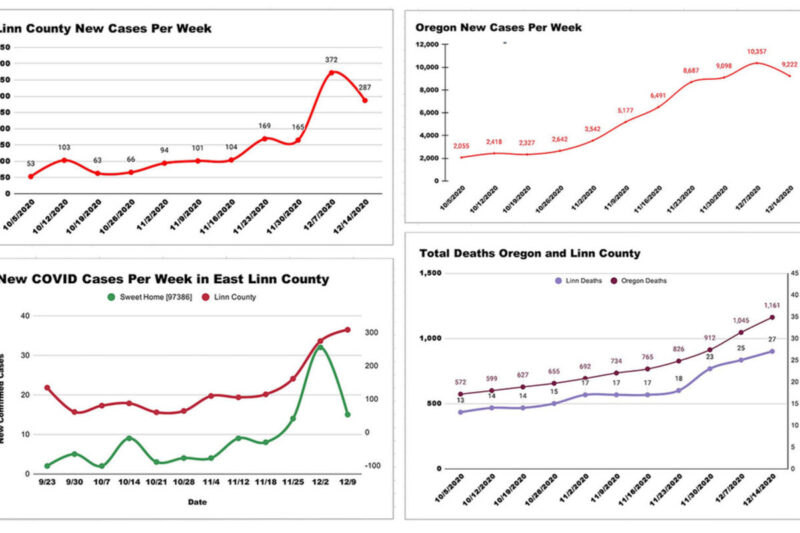Kelly Kenoyer
The rise of COVID cases in Linn County has pushed the possibility of in-person schooling far out of reach.
But Supt. Tom Yahraes said at a Dec. 14 School board meeting that he expects enrollment, which has dropped in recent months, to rebound once the pandemic is in the rearview mirror.
Board members Joe Kennedy, Dale Keene, Jim Gourley, Jason Reddick, Debra Brown, Mike Reynolds, Chanz Keeney, and Jason Van Eck attended the Zoom meeting, with Jenny Daniels absent.
Total enrollment in Sweet Home Schools is down to 2,099, compared to last year’s 2,320. More than 50 students have left the district since the beginning of this academic school year, though Yahraes said that is common at this time of year.
Yahraes said he plans to work hard to recoup enrollment declines after Christmas break, by “focusing on continuous improvement in academic program; and commitments to having great activities and athletics, community service, character development programs for students. In addition, we will add a stronger virtual learning component, and we will use this to recoup enrollment and build pathways to serve even more students in the region.”
COVID rates make it impossible to bring students back to school, at least in the short term. Schools can re-open to all students if their county has less than 50 cases per 100,000 in a two-week period, or less than 100 cases for a slower, phased transition with the youngest students first. But Linn County was at 505 cases per 100,000 for the time period of Nov. 29 to Dec. 12, and a test positivity rate of 10.6%.
“These limits are determined by the governor and enforced by [the Oregon Department of education],” Yahraes said. “These are not local orders.”
He also addressed recent outbreaks at two schools in Sweet Home: an outbreak of three coronavirus cases in Oak Heights Elementary, and two cases in the Junior High. Those outbreaks forced the district to pause limited in-person instruction for 14 days at each affected building for quarantine.
“We have had positive feedback from the state and county health authorities regarding our health and safety protocols,” Yahraes said. “As I mentioned in my messages to the community, the health officials are finding schools are not the source of the spread of COVID; rather our individuals’ social environments are.”
“There’s vaccines in sight, as you know, but there’s also increases in cases. Now, more than ever, we need to dig deep as a community, follow the health and safety protocols, bring down out case counts to get our kids back in school,” Yahraes said. “There’s light at the end of the tunnel.
In other board action:
– Chief Academic Officer Rachel Stucky presented a plan for the K-3 hybrid learning schedule once students are allowed to return.
“You may have heard the phrase, younger students learn to read and older students read to learn,” Stucky said, which is why getting the building block skills early is so vital.
Sweet Home first-graders take a “sounds in words” test related to their reading ability this year, and just 31% passed this fall, compared to 78% last year.
“There’s definitely a slide there and we need to be very rigorous with them,” Stucky said.
To address that challenge, “We’re opting to do five days a week for all students, a.m. and p.m. sessions,” she said, as required for social distancing standards.
But the district faces challenges in that because of limited resources.
“Our buses can’t hold more than 21 students at a time, unless we have siblings, so that also prevents us from having full-day full class every day,” Stucky said.
Students will be designated for morning or afternoon sessions, based partially on bus routes, as the routes will be divided in half. The district is also pushing parents to transport their own children rather than relying on the bus.
Beyond busing limitations, students will be placed in a.m. or p.m. based on “alphabetical order of last name,” she said. Students will also get both breakfast and lunch as take-home meals.
“We want to start as soon as we can but we need to get those metrics in a good spot in order to do that.”
For the older students, Stucky said the district will look at the “effectiveness of K-3” to make decisions for the rest of the students. It’s also looking at alternate models for other schools.
The Junior High, for instance, might do two full days a week for seventh grade and two full days a week of eighth, depending on bus availability.
Each school wants to hear from families who are willing to forgo busing in favor of their own transportation, Stucky said, as it will help them make decisions about scheduling.
“For grades 4-6, I wish to commend publicly the work our staff have done at the four grade schools. Our elementary principals have done a great job of working with parents to identify who would be able to self-transport rather than take the bus.”
That information has allowed the schools to plan for four days a week of a.m. and p.m. classes for grades 4-6, which is more than the district expected to get, Stucky said.
“The high school is looking at half days,” she added.
– Board members voted unanimously to accept gifts from donors: Tim and Mary Kaye Barton’s donation of a washing machine to Holley Elementary, as well as a financial gift of $300 from Artemis Partner Anne Aldrich of Grand Rapids Mich.
– Business Manager Kevin Strong said the district has spent $108,600 less this fiscal year compared to last. He said the savings came from using fewer substitutes, some unfilled classified positions, and from using less bus fuel.
“Those savings have been partially offset by higher spending on technology, and I expect that to remain the case throughout the rest of the year,” Strong said.
Additionally, a return to in-person classes under the plan described above would substantially impact both fuel costs and personnel, which will be a significant expense. Districts do get a little bit of reimbursement from the state for transportation, he said, but the pot of money available may be reduced significantly if every school district increases their bus routes the same way Sweet Home plans to.
– Strong also addressed how the governor’s budget plan will impact SHSD.
Gov. Kate Brown is planning for $9.1 billion for the state school fund, which is a $100 million increase from the last biennium.
Strong said the prospects for state-level funding in the coming biennium is “better than we expected than what we were hearing six months ago,” but said the increase is just 1.1%, so it isn’t substantial.
He said revenue from Measure 98 and the Student Investment Act have seen larger increases, but those funds have limitations with specific requirements. Enrollment also poses a challenge, he said, “so we hope the students who left this year will return next year.”
– Construction on the Junior High has been held up by a delay on the delivery of some windows for the gym on the west side of the building. Facilities Manager Josh Darwood said girding is supposed to be done in February, and he plans to finish the building by Spring Break.
“We should be able to be completely out of there, as far as construction, at that point,” he said.
The school also has new LED lighting in the classrooms and hallways.
“It doesn’t look like you’re going from an old building into a new one quite as bad.”
Additionally, he said, construction related to the seismic upgrades and remodeling at Foster and Holley has been completed.
Schools are now all equipped with electrostatic sprayers, he added. Darwood then showed a video demonstration of the contraptions, which look like oversized Nerf guns. The electromagnetic charge on the cleaning spray helps it attach to both sides of an object, rather than just the surface the operator is spraying it at.
“Every school is equipped with these, the high school has two backpack models and the junior high has one backpack model,” he said.
– The board held two executive sessions the same evening: one to discuss licensed bargaining, and one for the superintendent’s evaluation.





